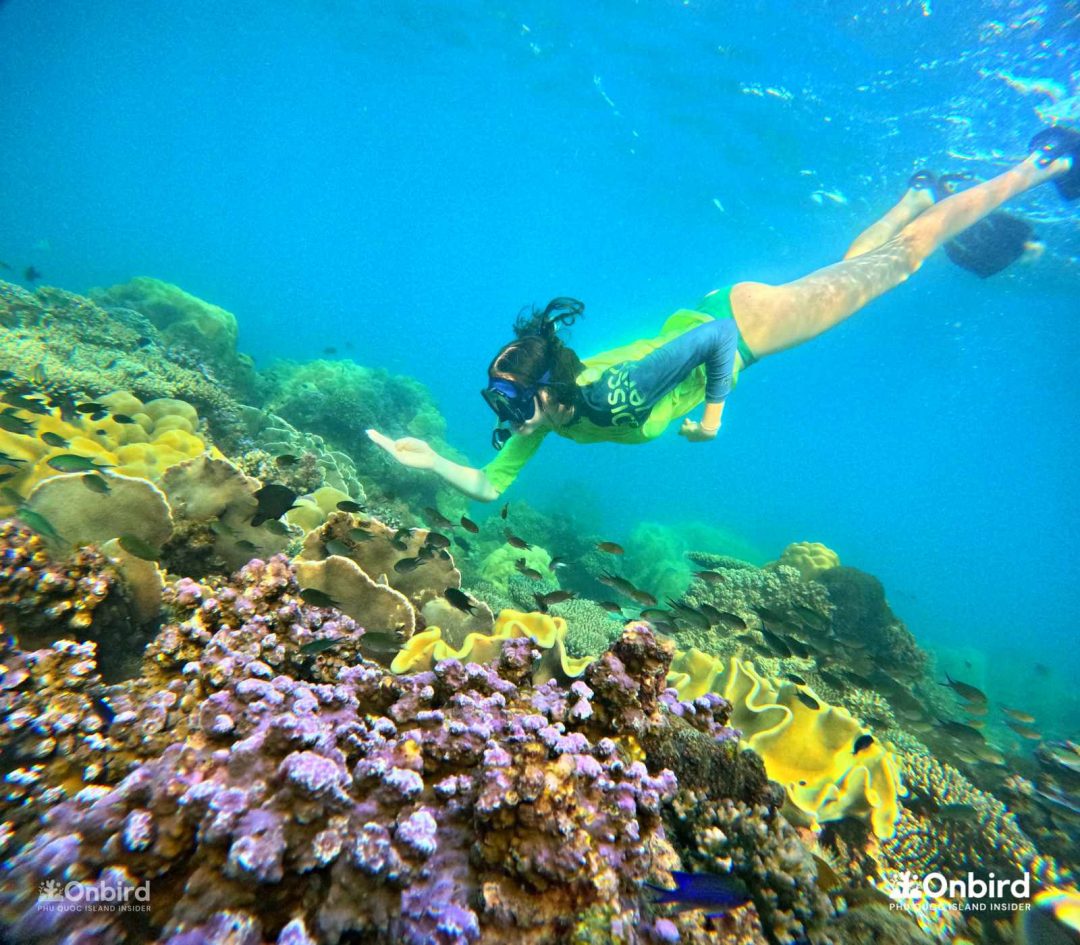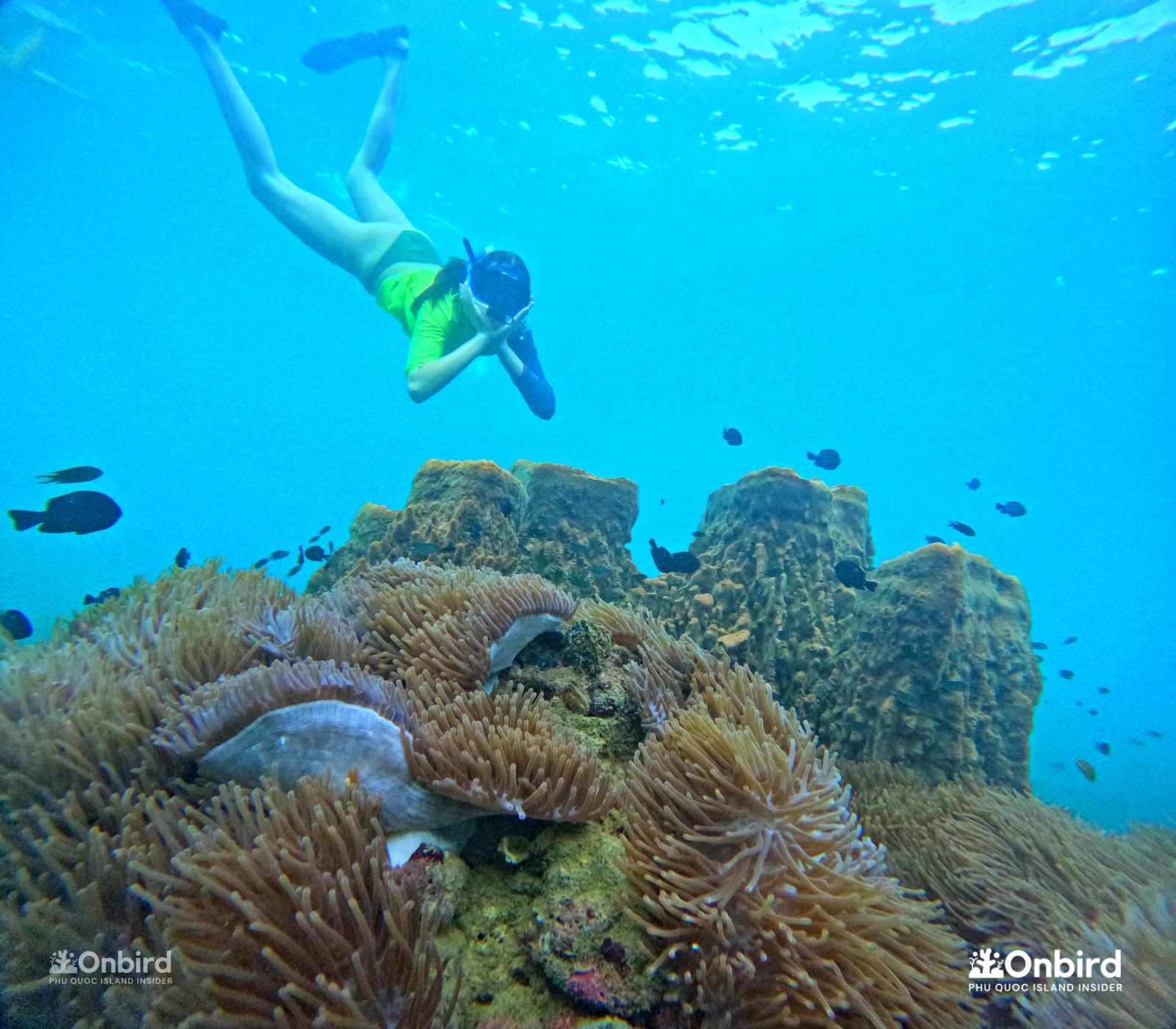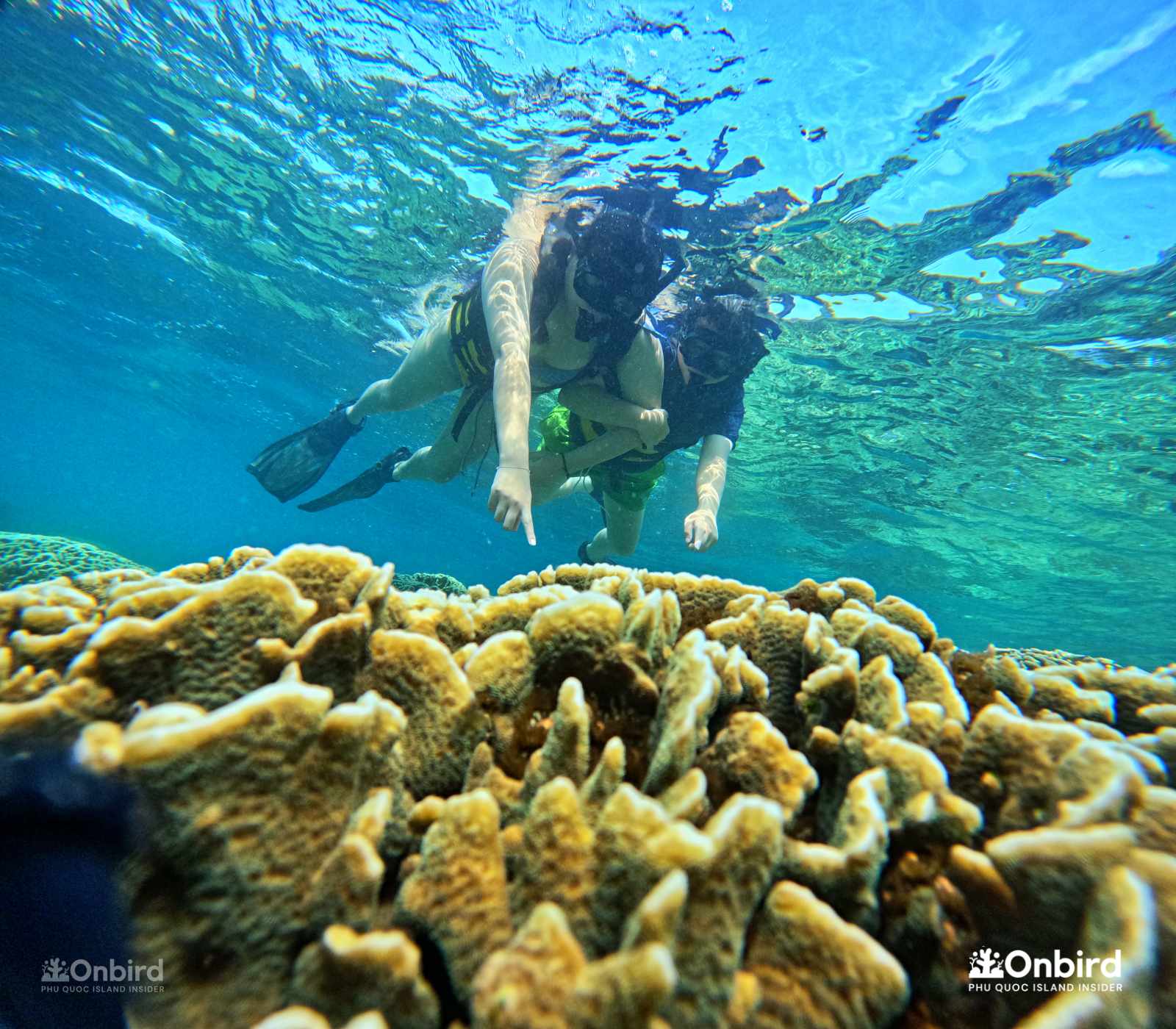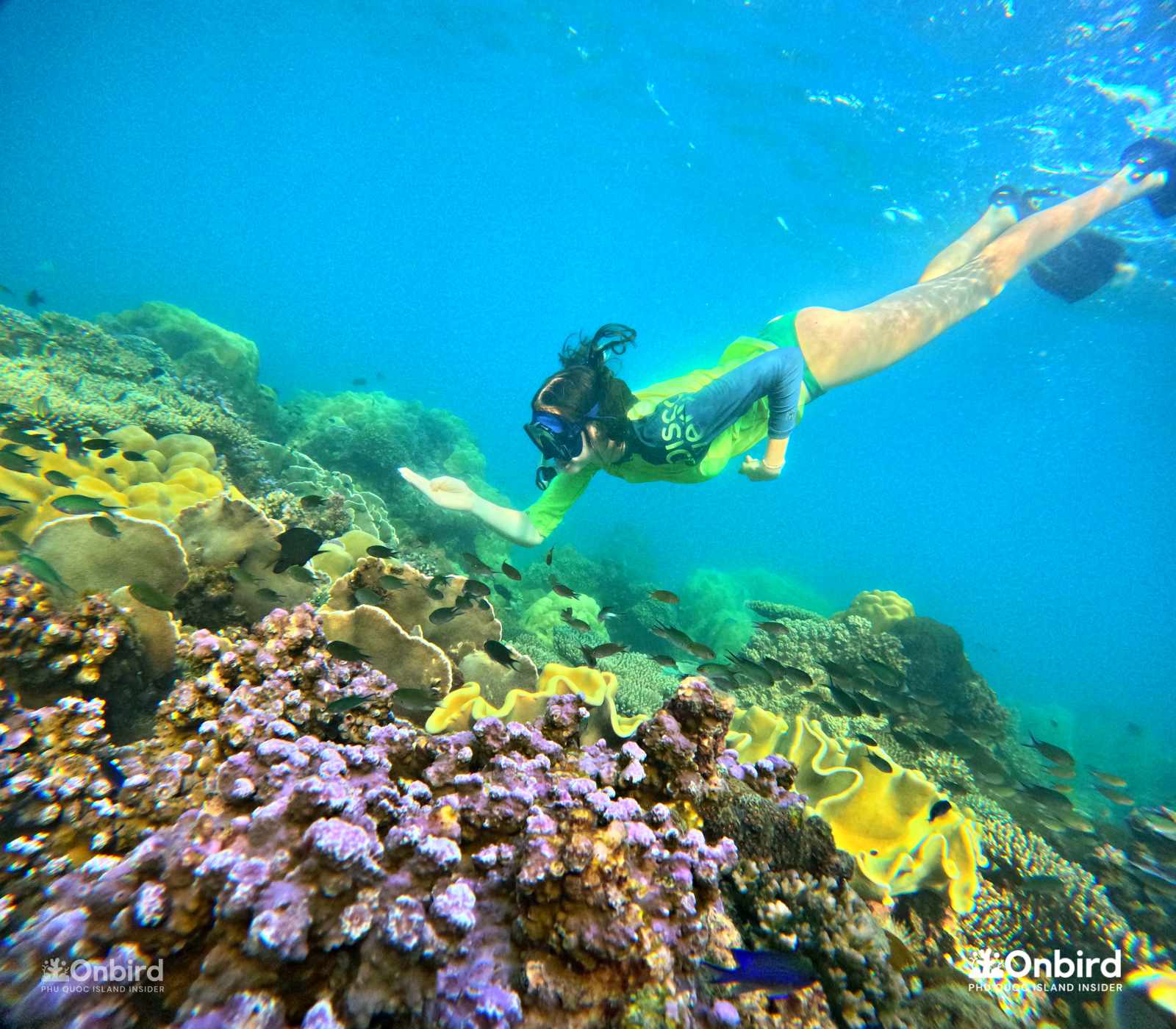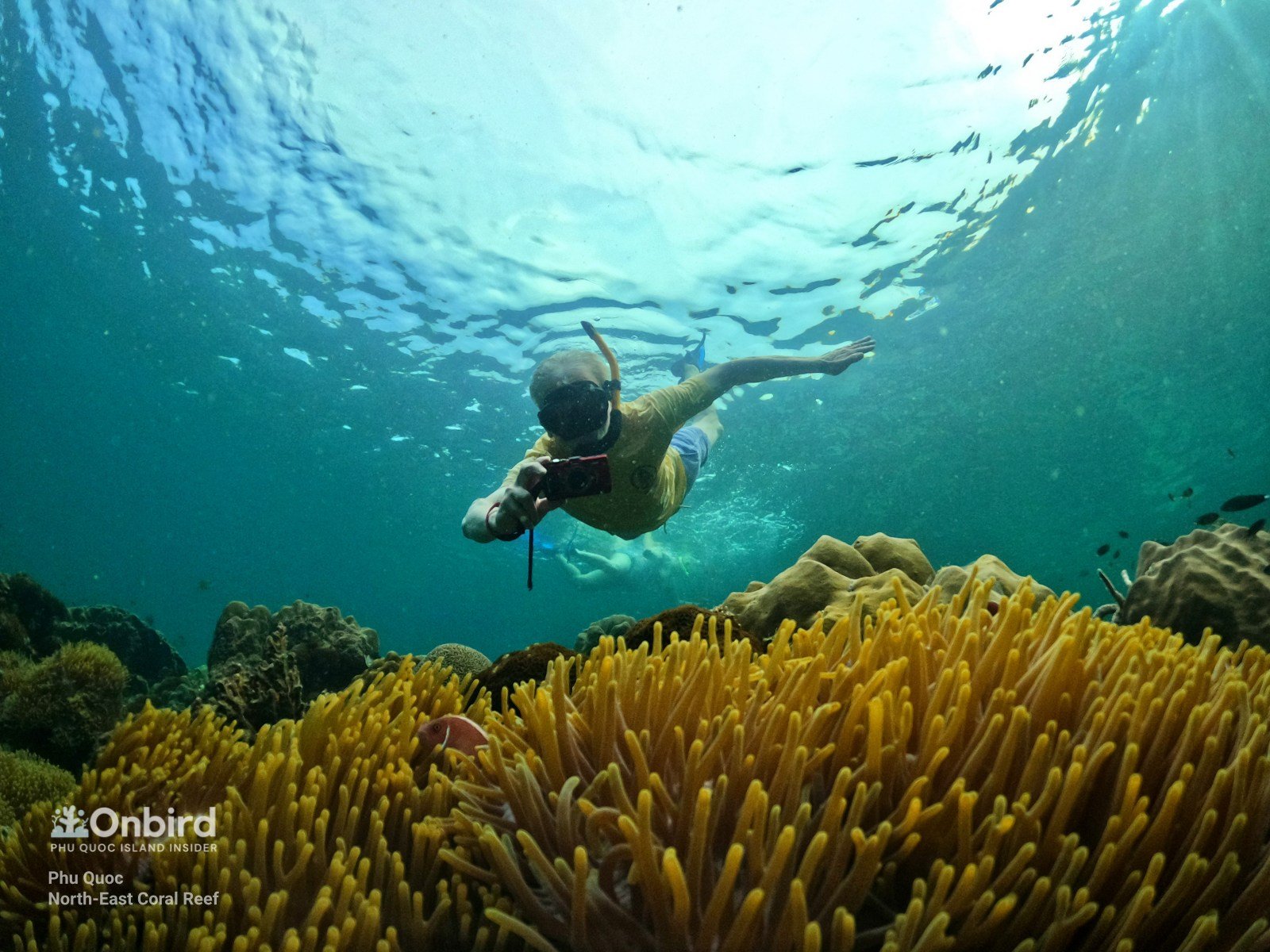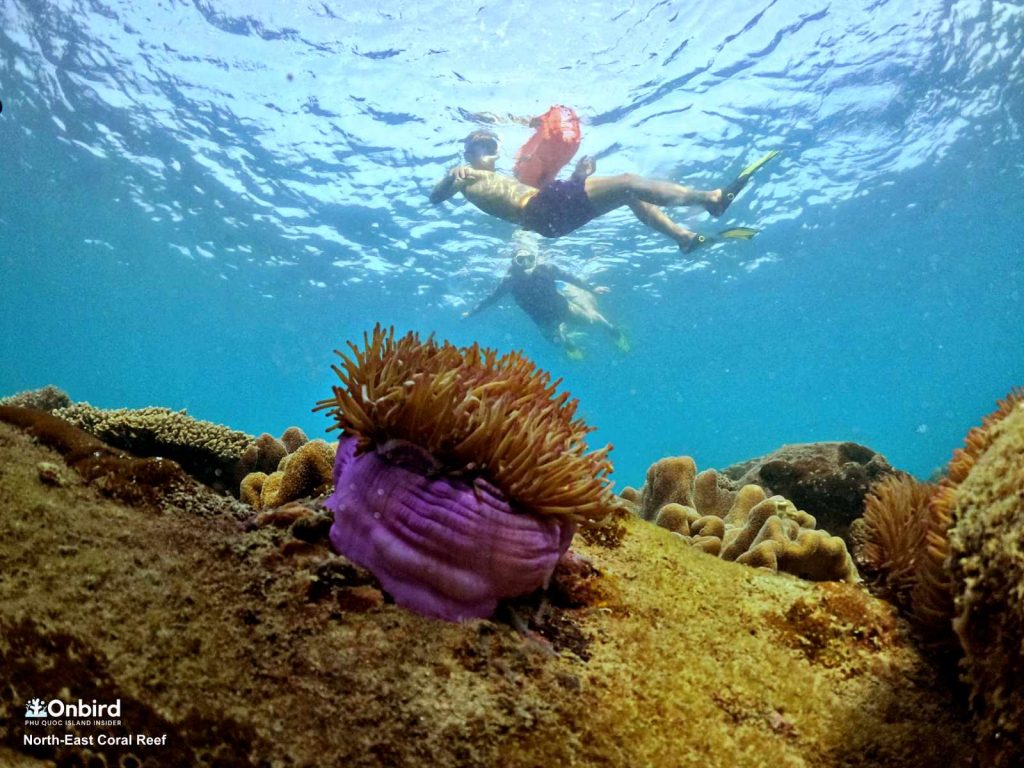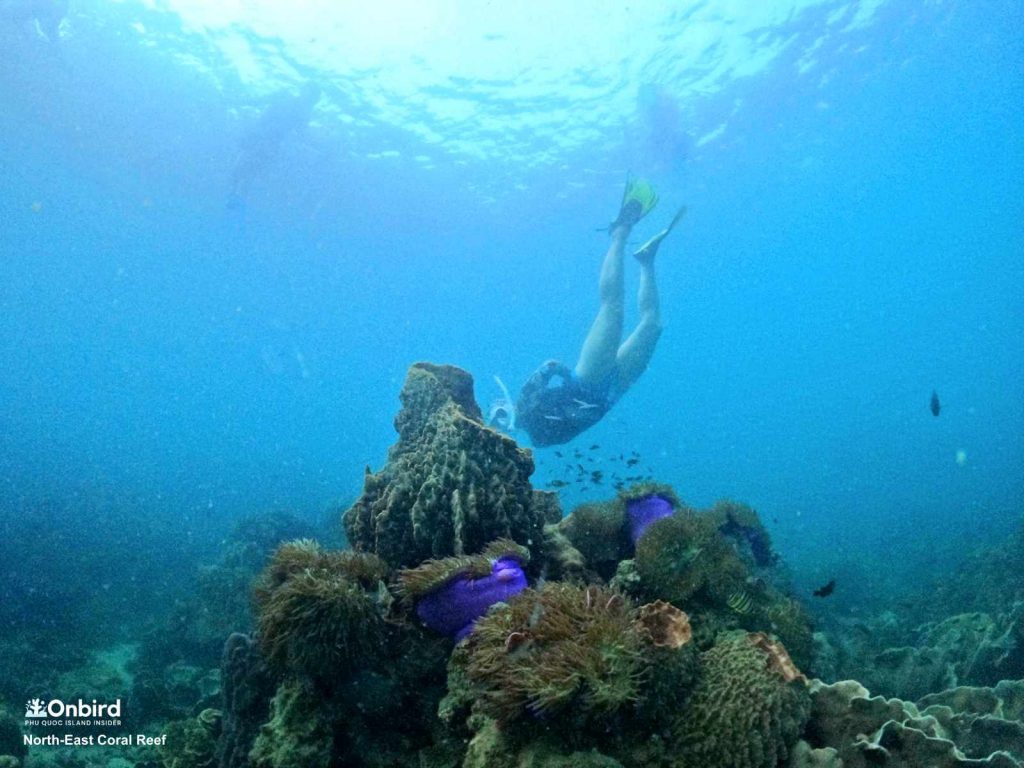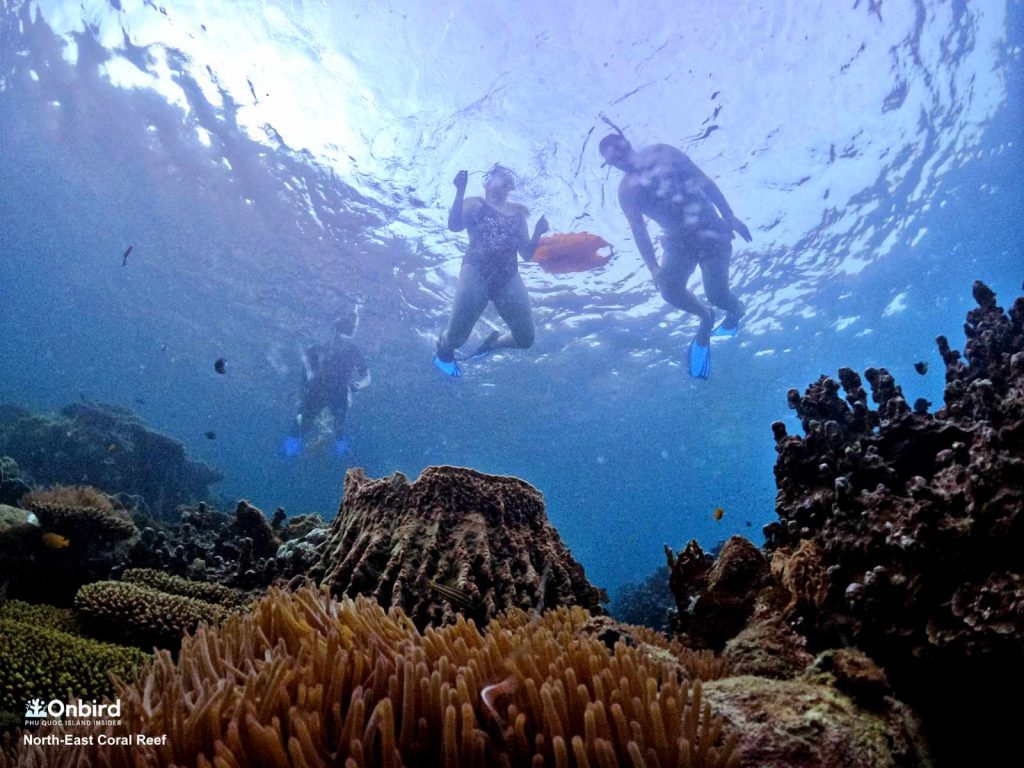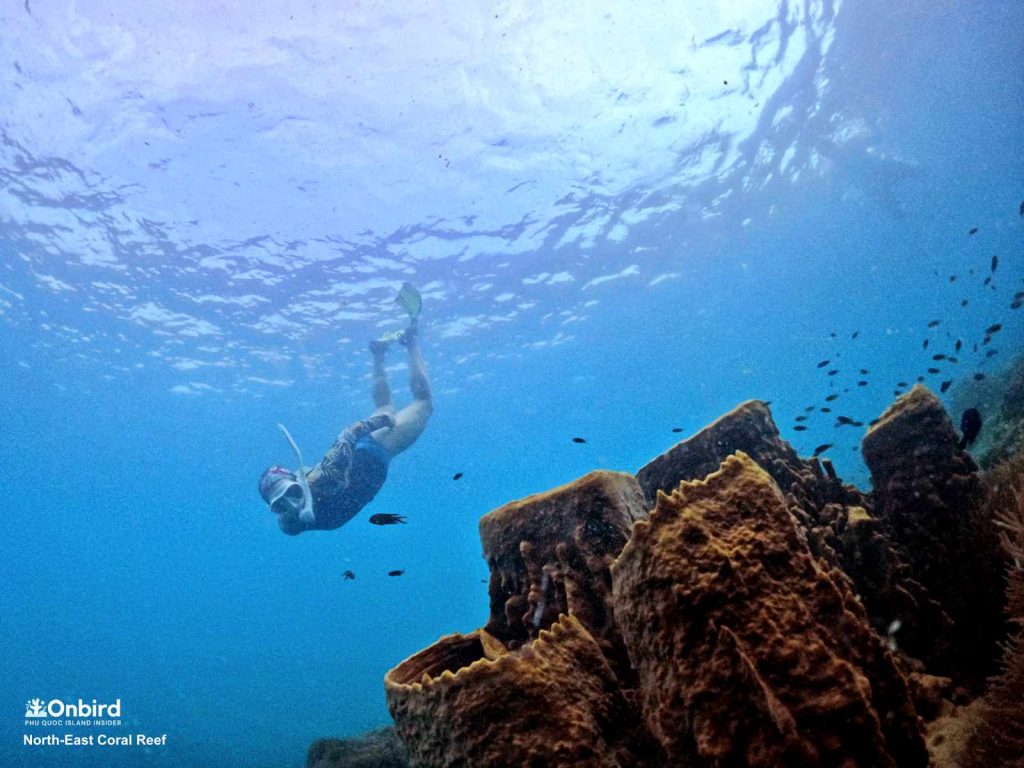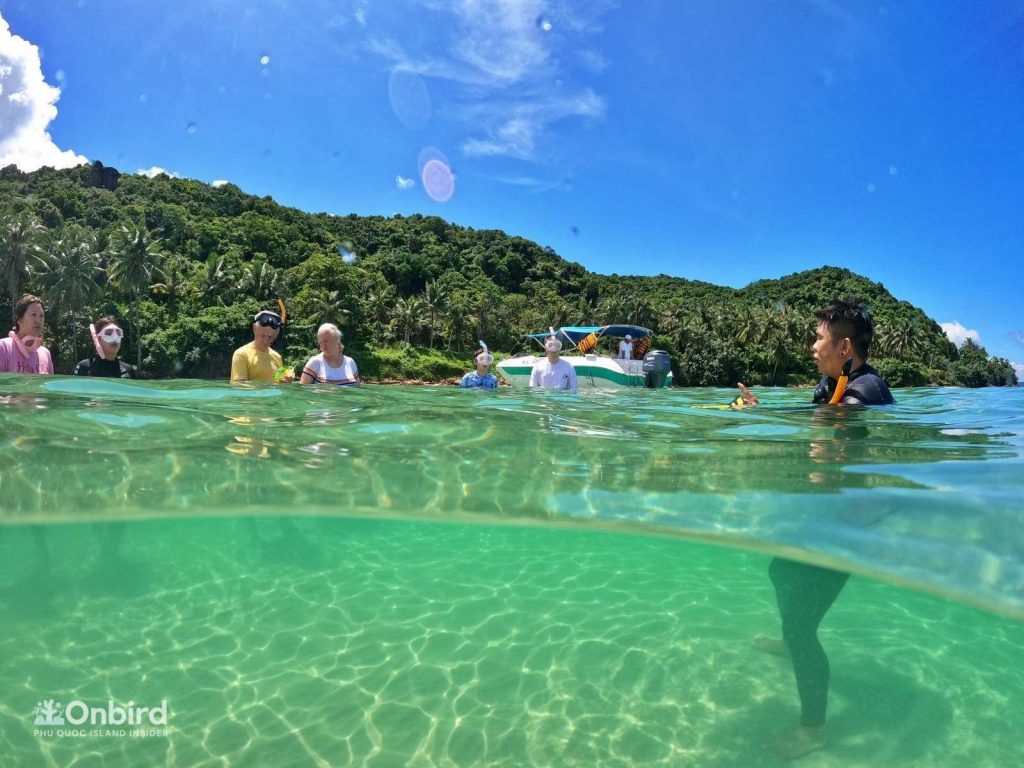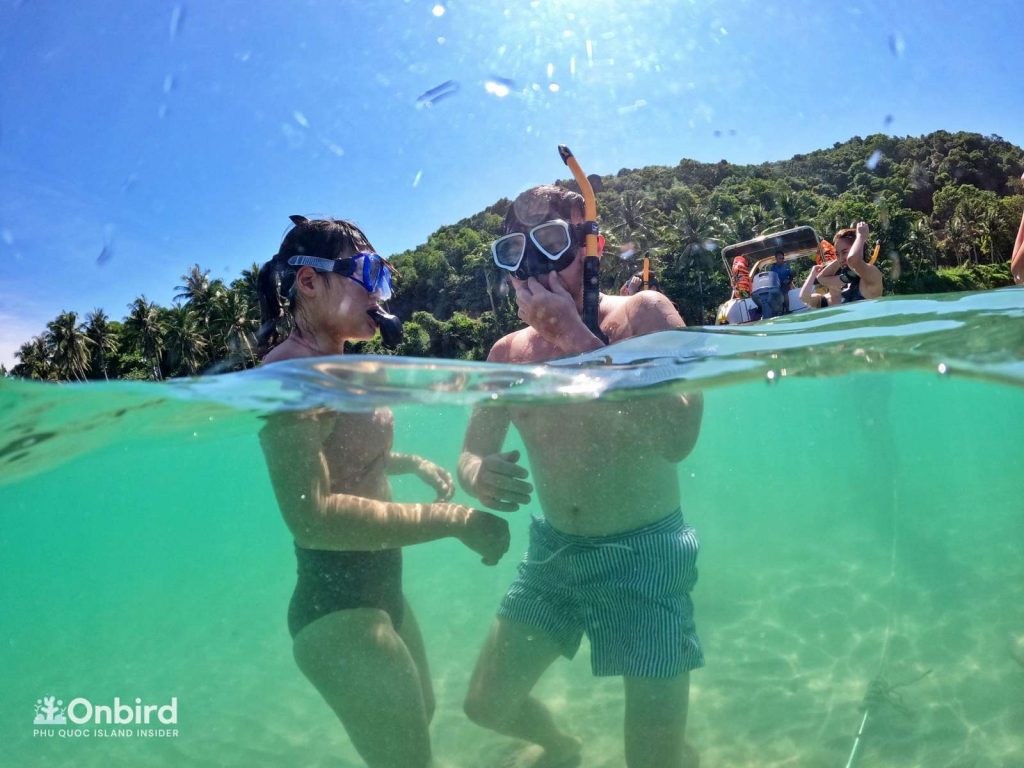Before reading the following article, please take a moment to look at the picture.
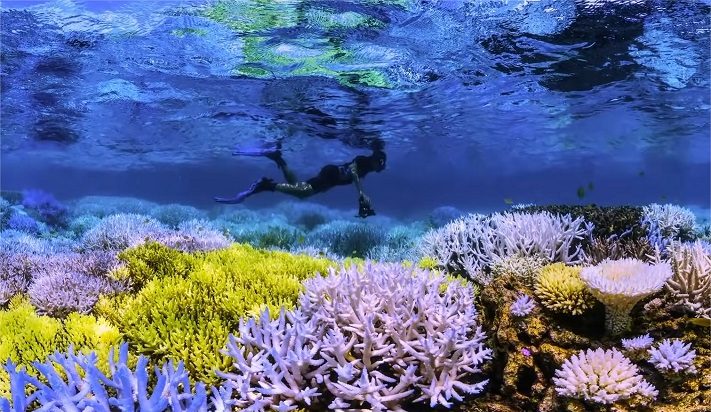
Isn’t this an amazing view? Wouldn’t you love to see it firsthand while snorkeling?
This captivating scene from the documentary “Chasing Coral” mesmerizes viewers with the breathtaking beauty of a vibrant coral reef in New Caledonia. It illustrates one of nature’s most remarkable transformations.
Some footages of coral reefs in Phu Quoc (Learn more about Phu Quoc’s coral reefs and the various coral species found there).
However, what you may not know is that this is actually a stunningly beautiful stage of coral bleaching.
You will be truly amazed to discover that corals naturally produce a “chemical sunscreen” to shield themselves from the warming effects of seawater. The stunning hues of coral reefs stem from a remarkable symbiotic relationship with a type of algae known as Zooxanthellae, which resides within their tissues. These algae provide vital nutrients to corals, fueling their growth through the process of photosynthesis. However, when faced with external stressors such as temperature changes or pollution, the algae release harmful oxidizing agents, causing the corals to undergo stress. In response, corals expel the algae, resulting in a bleaching phenomenon where they become translucent. Coral reefs can survive bleaching events but they are at risk—primarily from compromised immunity—and ultimately face starvation, turning a dark brown colour.

These events unfold quietly beneath a floating restaurant, where partying tourists discard waste directly into this beach area. The film crew had to navigate through the hull of a boat to access a portion of the coral reef and document the silent devastation, unbeknownst to any of the guests above.
That scene haunts many with the message the coral itself seems to convey.
“Look at us. Please pay attention!”
The documentary “Chasing Coral,” released in 2017, chronicles the expedition of a diverse team of divers, scientists, and photographers across the globe, meticulously recording the vanishing coral reefs. It stands as a poignant reminder, a clarion call alerting us to the environmental degradation wrought by human-induced adversities.
MAIN CONTENTS
I. HOW DEEPLY SIGNIFICANT ARE CORAL REEFS THAT THEY CAPTURE EVERYONE’S ATTENTION?
Known as the “tropical rainforests beneath the sea,” coral reefs hold immense value for marine ecosystems and humans, including:
- Although coral reefs cover a small portion of the ocean, they are vital habitats for many marine species, providing breeding, spawning, and nursery grounds. These reefs sustain approximately 25% of all marine life, including over 4,000 species of fish. Remarkably, more than 70% of juvenile reef fish are drawn to the scent emitted by live corals. Without coral reefs, these fish would struggle to survive against predators, leading to ecological imbalances and disruptions in the global food supply chain. This could potentially result in mass extinctions that directly affect human populations.
- They provide a crucial food source for numerous marine species through various biogeochemical processes.
- Coral reefs serve a crucial function in creating protective coastal barriers, mitigating the impact of large waves, winds, storms, floods, and slowing currents to prevent erosion. They play a key role in shielding coastlines from the effects of storms.
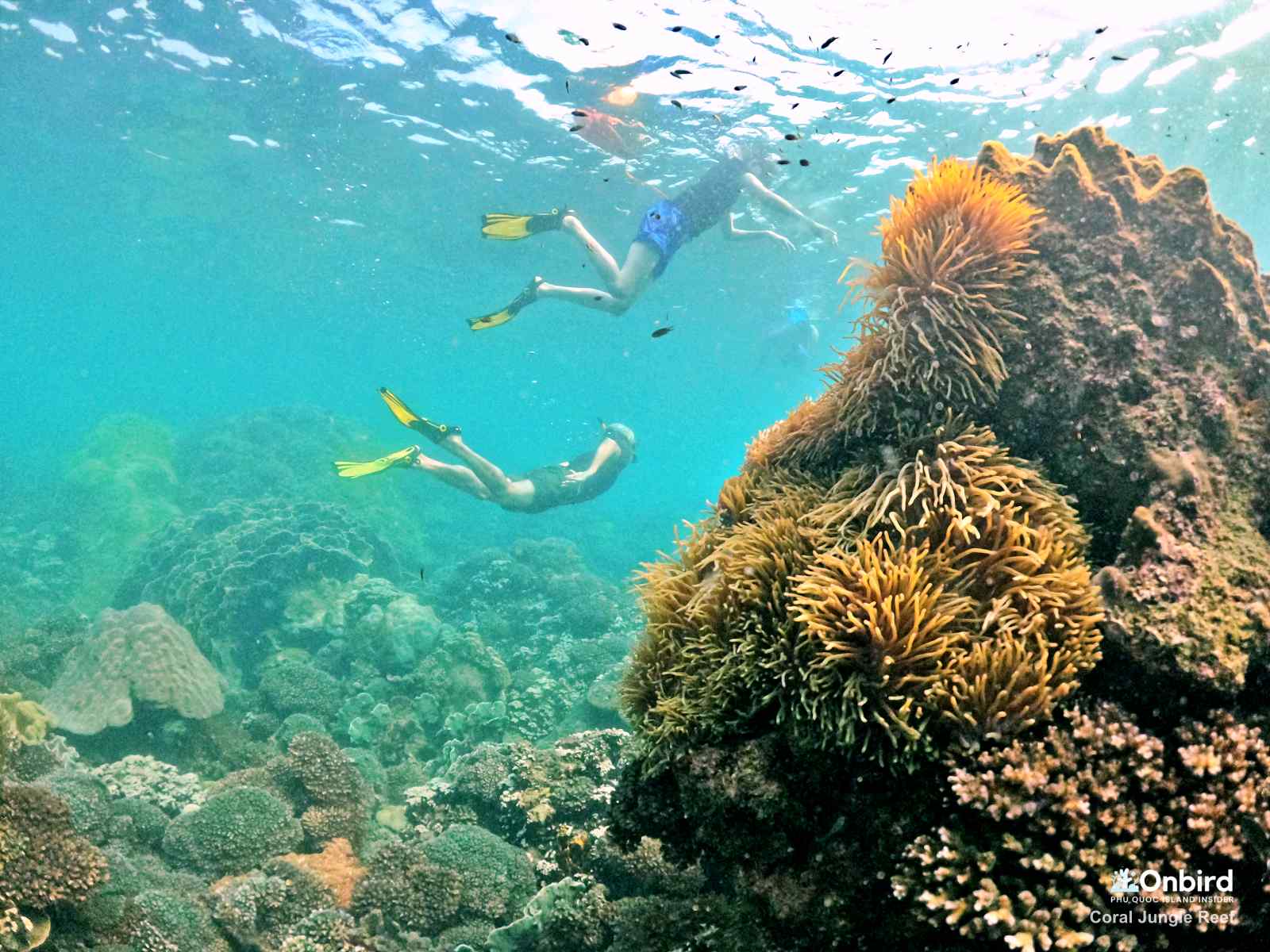
- Additionally, coral reefs’ captivating allure makes them a distinct attraction for both domestic and international tourists, facilitating tourism operators in arranging snorkeling excursions. Furthermore, they serve as a means of livelihood for many generations of fishermen, fostering economic and tourism growth in local communities. It is estimated that around 500 million people earn a livelihood from the exploitation of marine resources and the tourism opportunities provided by coral reefs.
- Playing a crucial role in reducing carbon dioxide (CO2) emissions, zooxanthellae algae, which live symbiotically with corals, absorb carbon from the atmosphere through photosynthesis and convert it into a form that corals can utilize. Corals, in turn, transform this carbon into calcium carbonate (secreting calcium to build their skeletons), thus sequestering a portion of carbon beneath the ocean floor. Similar to humans, corals also require oxygen for respiration, a process that releases a certain amount of carbon dioxide. However, the carbon dioxide absorbed by corals surpasses the amount they emit.
Professor of Marine Sciences Stephen Palumbi at Stanford University once stated: “If you were to pick an ecosystem on which human well-being pivots, coral reefs would be up there in the top three.”
II. CURRENT THREATS CORAL REEFS ARE FACING
Despite their significant value, coral reefs also face numerous threats to their survival, stemming from natural forces, human activities, and other natural enemies.
Nature
- Big waves from storms can be the cause of breaking or flattening large coral heads
- Coral reefs are vulnerable to falling tides, especially when water levels drop too low, exposing coral heads to the sun’s radiation. This exposure can lead to the drying out of coral tissues
- Under the impact of climate change, rising temperatures cause sea water to warm. Just a 1°C increase in temperature can cause problems in the balance of the symbiotic relationship between algae and coral. While symbiotic algae provide corals with up to 80% of their total food needs. Breaking the symbiotic relationship between algae and coral causes the coral skeleton to be exposed to direct sunlight, causing the coral to become bleached and gradually die.

A photo of sea anemones taken by a UK guest at the Northeast Reef in Phu Quoc in August 2022
Human
- The development of exploitation and fishing activities, along with inadequately designed diving tours (island hopping, snorkeling, and scuba diving) that prioritize economic benefits over protection measures, greatly impacts coral reefs.
- Tourists’ awareness when participating in undersea activities such as littering, changing natural structures, using sunscreen with substances that affect coral habitat, trampling when joining amateur coral viewing tours, unintentional mooring by tourist boats, etc.
- Furthermore, in certain coastal areas in Vietnam, there is a concerning trend of manipulating coral for decorative purposes (such as decorative stone structures, miniature landscapes, and home decorations). Instead of harvesting corals directly, people plant explosives, causing coral pieces to disintegrate. These fragments are then collected, transported, and processed into limestone.
Human awareness in safeguarding coral reefs is paramount for their survival.
Natural Enemies
Due to the benefits they offer, coral reefs attract a variety of creatures including box starfish (Acanthaster planci), peanut worms, sea mantises, crabs, snails, and others that prey on the soft tissues inside coral polyps. However, if the predator population becomes excessive, it can negatively impact the growth and development of coral species.
III. HOW WE CAN PROTECT CORAL REEFS?
Since images of coral reefs before and after being impacted by various factors have not been widely circulated, it’s challenging for us to fully grasp their significant loss. If we aim to prevent coral “jungles” from facing this plight, each of us must take action now and unite to protect Phu Quoc’s corals. This can be achieved by implementing measures such as:
- Establishing coral nurseries to propagate and cultivate coral reefs, with the aim of transplanting them into natural habitats to replenish and rejuvenate dead and aging coral reefs.
- Replanting coral reefs (a method that has been applied by OnBird to regenerate and partially restore the reef’s areas that was trampled or moored)
- Participating in trash collection activities and ghost net cutting initiatives with OnBird underwater instructors, volunteer organizations,…
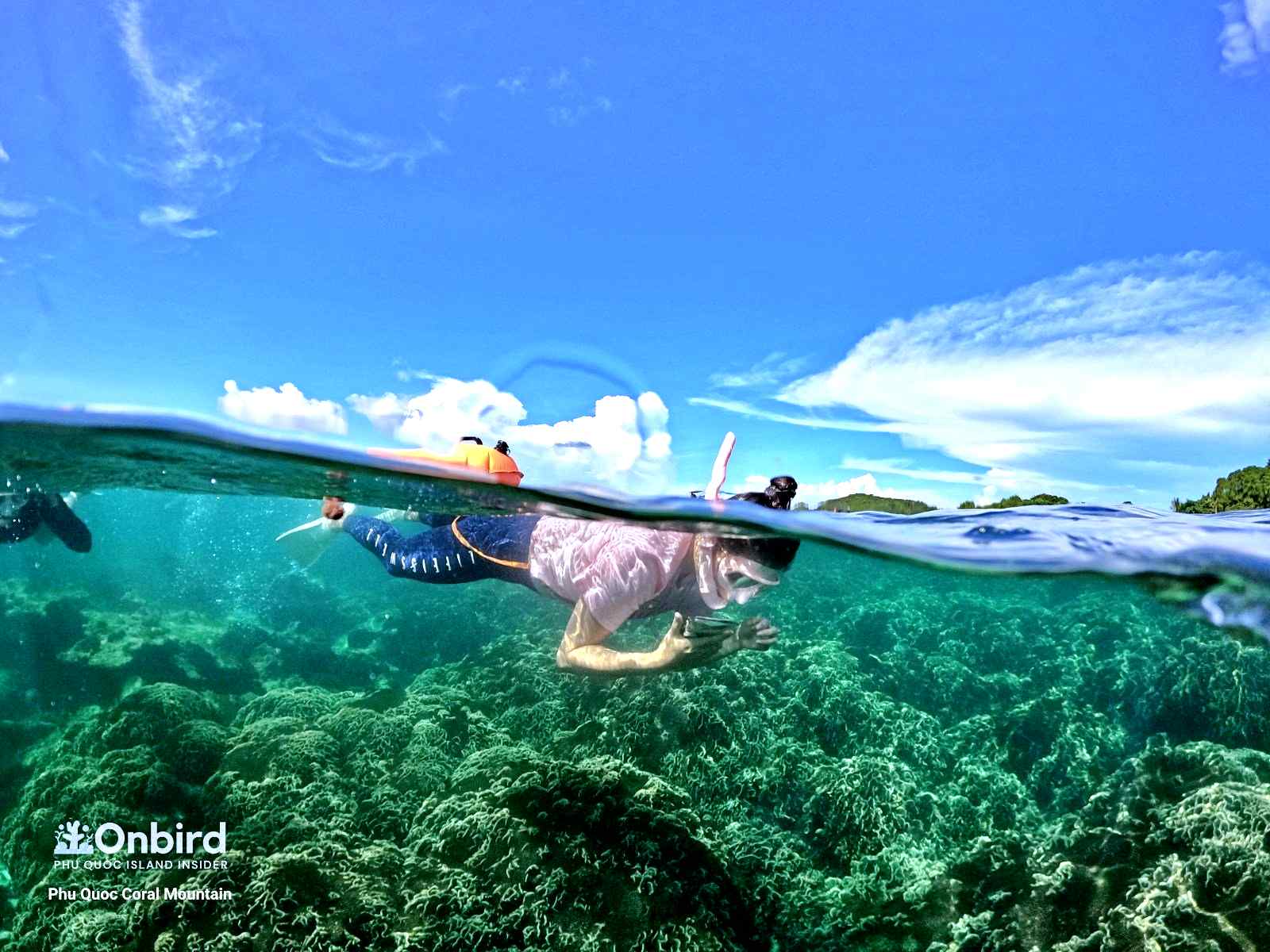
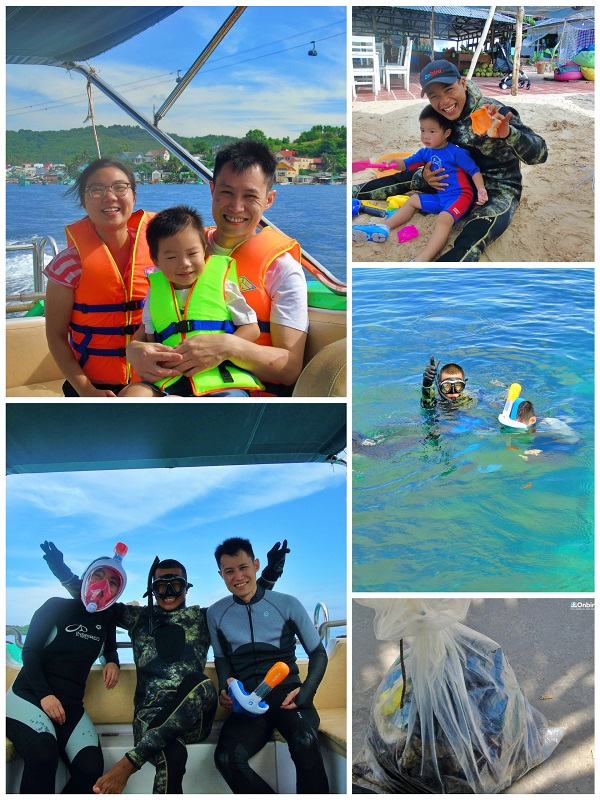
- Supporting projects, conservation centers, and organizations dedicated to marine conservation efforts aimed at protecting coral reefs and essential organisms like parrotfish and conch snails. These initiatives also focus on managing natural threats in Vietnamese waters, with key players such as the Museum of Oceanography and the SASA team, and knowledge-sharing platforms like sanhovietnam.vn.
- Anchoring underwater vehicles securely and responsibly
- Engaging in responsible travel and exploration, employing coral-friendly sun protection methods.
- Make informed decisions when selecting snorkeling and diving tours that prioritize extensive research on location, timing, hydrological conditions, and operational principles dedicated to the protection of coral reefs. Opt for from a selection of vibrant and pristine coral reef sites, including Halfmoon Reef, Coral Mountain, Northeast Coral Reef, and Coral Jungle Reef. These tours are led by experienced underwater instructors who offer guidance on proper snorkeling techniques for safe coral viewing. By engaging in these tours, you play a part in mitigating the impact on coral reefs. Discover more snorkeling tours to explore thriving coral reefs with OnBird and contribute to coral protection initiatives.
- Learn more about coral information in Phu Quoc via here
Ghost nets removing activities in the coral reefs
Recognizing the crucial role of corals in marine and terrestrial ecosystems, OnBird designs immersive exploration experiences focusing on marine life, while fostering awareness of coral conservation among visitors. Additionally, coral rescue efforts are integral. Ongoing activities involve removing fishing nets abandoned at sea, inspecting coral reefs to identify and remove ghost nets entangled with and threatening coral life. The OnBird Underwater Instructors strategize and execute the gradual removal of these ghost nets to facilitate coral recovery.
7 TIPS FOR YOUR RESPONSIBLE SNORKEL IN PHU QUOC ISLAND
7 LỜI KHUYÊN CHO MỘT CHUYẾN LẶN BIỂN CÓ TRÁCH NHIỆM TẠI ĐẢO PHÚ QUỐC
“Feed the Ocean” Campaign
Chiến dịch Làm Giàu Cho Đại Dương mà OnBird đang tham gia triển khai tại Phú Quốc với mong muốn đóng góp sức nhỏ để bảo tồn rạn san hô đang suy thoái tại Phú Quốc: đây là chiến dịch đưa một số sinh vật biển trở lại rạn san hô với mong muốn khôi phục đàn và bảo tồn loài, cân bằng sinh học tại rạn san hô ở Phú Quốc vốn đang chịu suy thoái nghiêm trọng từ hoạt động đánh bắt cá gần bờ quá mức, khai thác du lịch thiếu trách nhiệm.
https://onbird.vn/feed-the-ocean-conserve-phu-quoc-marine-life/
A Vietnamese website providing information about coral reefs.
Our product team has developed a website providing information about corals in Vietnam in general, with a focus on those found on Phu Quoc Island, starting in early 2023.
San Ho Viet Nam was established to disseminate valuable information and knowledge about corals and marine life, to enhance awareness among the Vietnamese people regarding the critical role of marine ecosystems, corals, and their direct impact on the livelihoods and economic benefits of the local.
The information on our site may inevitably have some shortcomings or be subject to controversy. We actively welcome readers’ suggestions to enhance the quality of the content we share. Therefore, readers, please feel free to let us know if you have any further contributions. Additionally, please promptly share with OnBird any other methods of protecting coral reefs, so that together we can foster a responsible tourist community when visiting the waters of Phu Quoc.
- Discover more about Phu Quoc’s coral reefs and join OnBird for an unparalleled snorkeling and diving tours, where we follow distinct crowd-avoiding routes to explore the hidden coral reefs.
- For additional guidanceon traveling to Phu Quoc and following itineraries to avoid crowds while having an authentic experience, click here. ✨
Learn more about disguised coral restoration
Currently, coral restoration projects are extensively promoted in various locations across Vietnam, such as Co To Quang Ninh, Nha Trang, and Phu Quoc. We can offer deeper insights into identifying these projects, ensuring that tourists can distinguish between promotional efforts and practical initiatives. Here’s how:
- Coral Cultivation Project on Water Pipes: Corals are cultured to transform into durable, permanent structures, such as rocks and deceased coral formations.
- The primary coral variety is staghorn coral, known for its rapid growth rate, which is reflected in the report findings. However, staghorn corals are fragile and prone to mortality, especially when disturbed. Moreover, their aggressive growth can hinder the growth of other coral species on the reef by overshadowing them. A coral nursery typically comprises various species, with samples cut into smaller fragments. Once these fragments grow larger, they are transplanted onto natural reefs.
Disguised coral projects may mislead tourists and locals, serving ulterior motives for personal gain.



 中文
中文 한국어
한국어 Tiếng Việt
Tiếng Việt